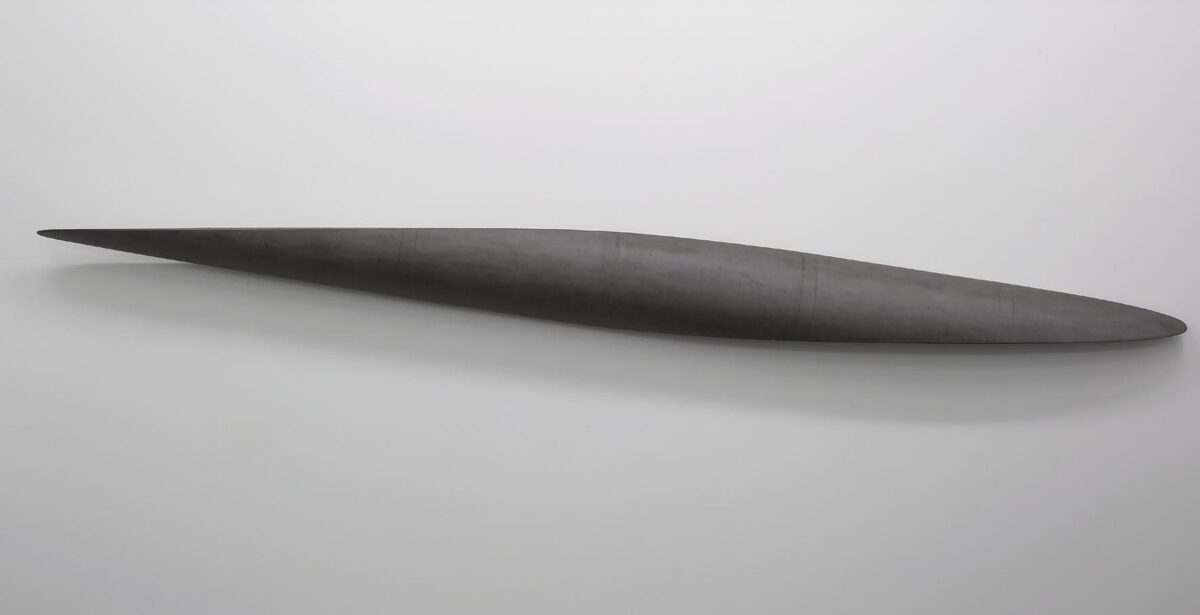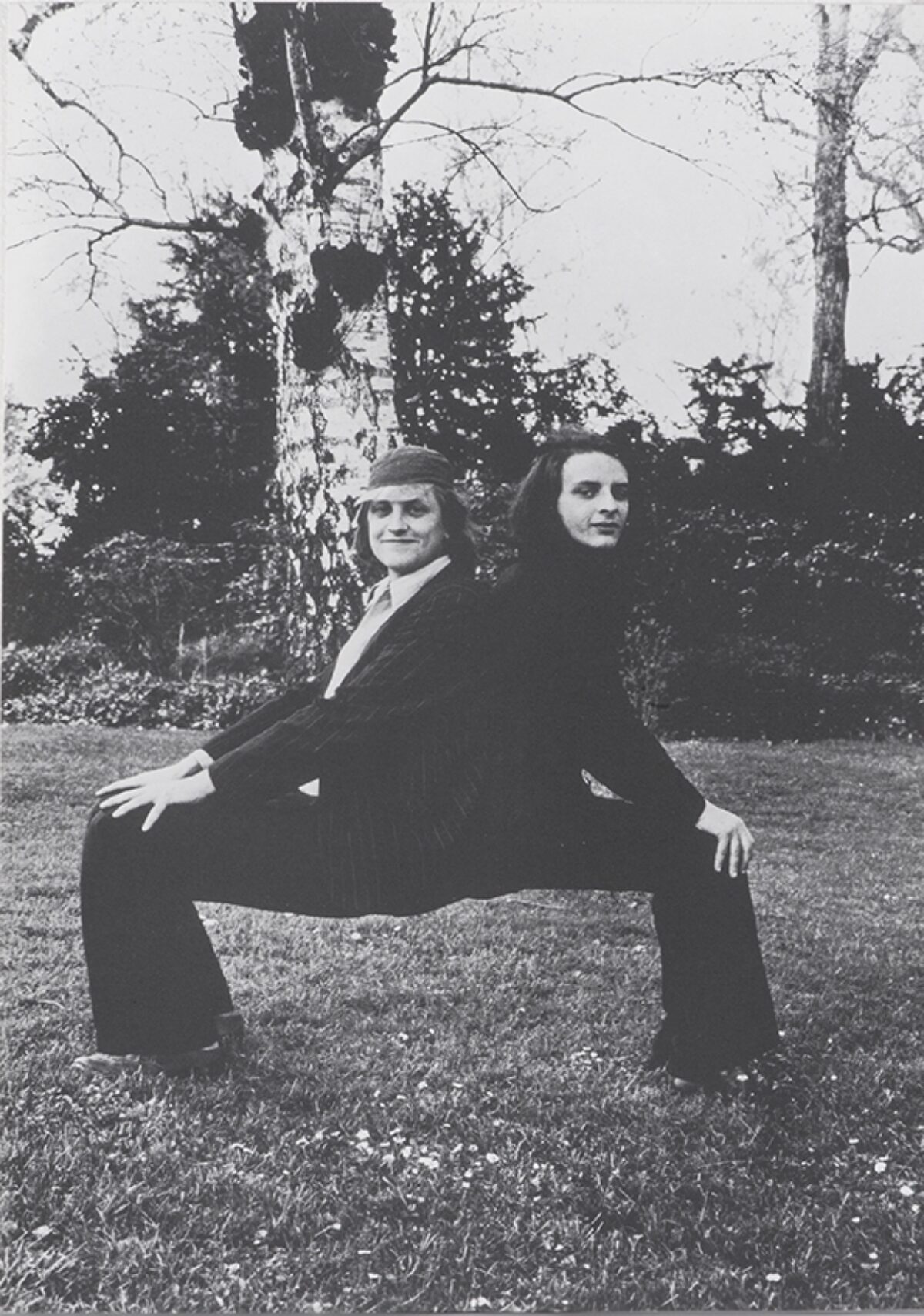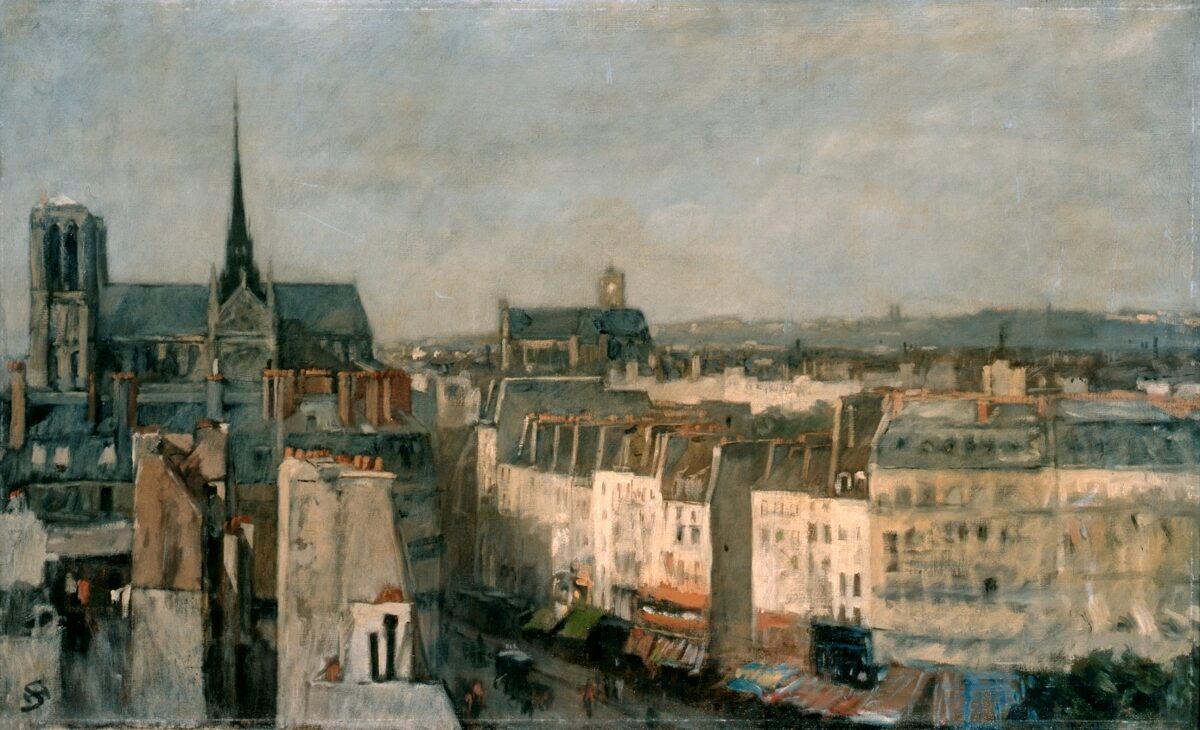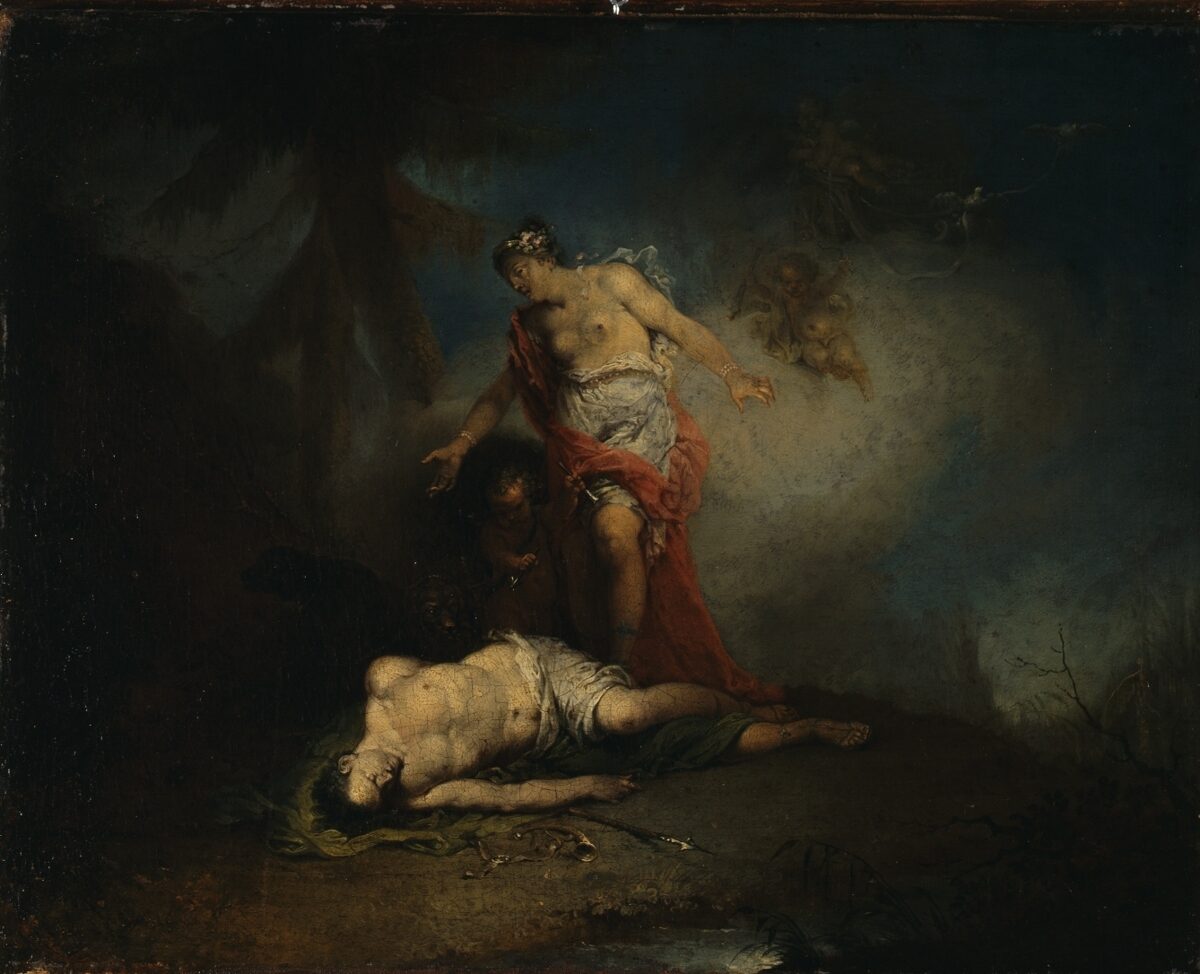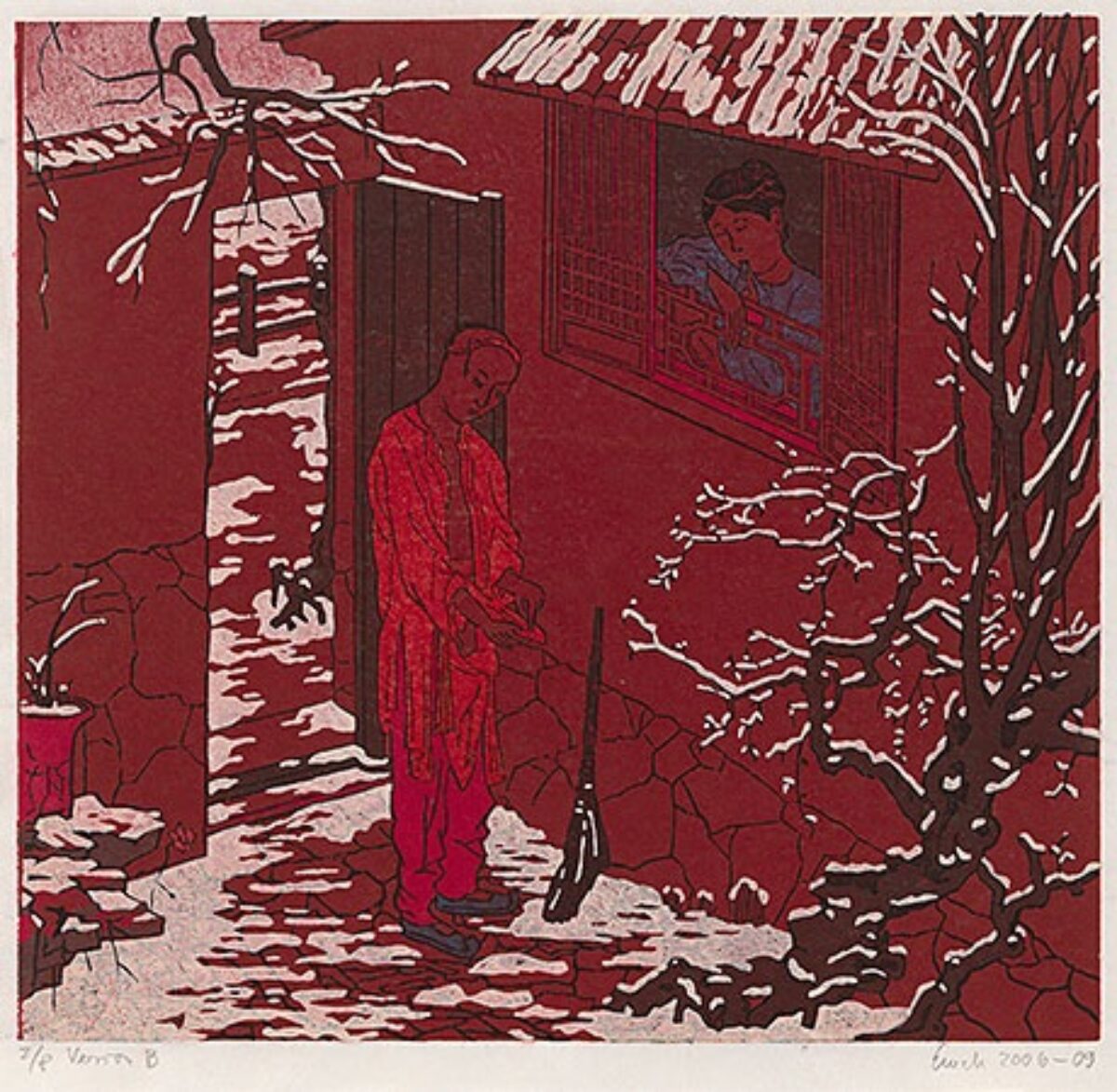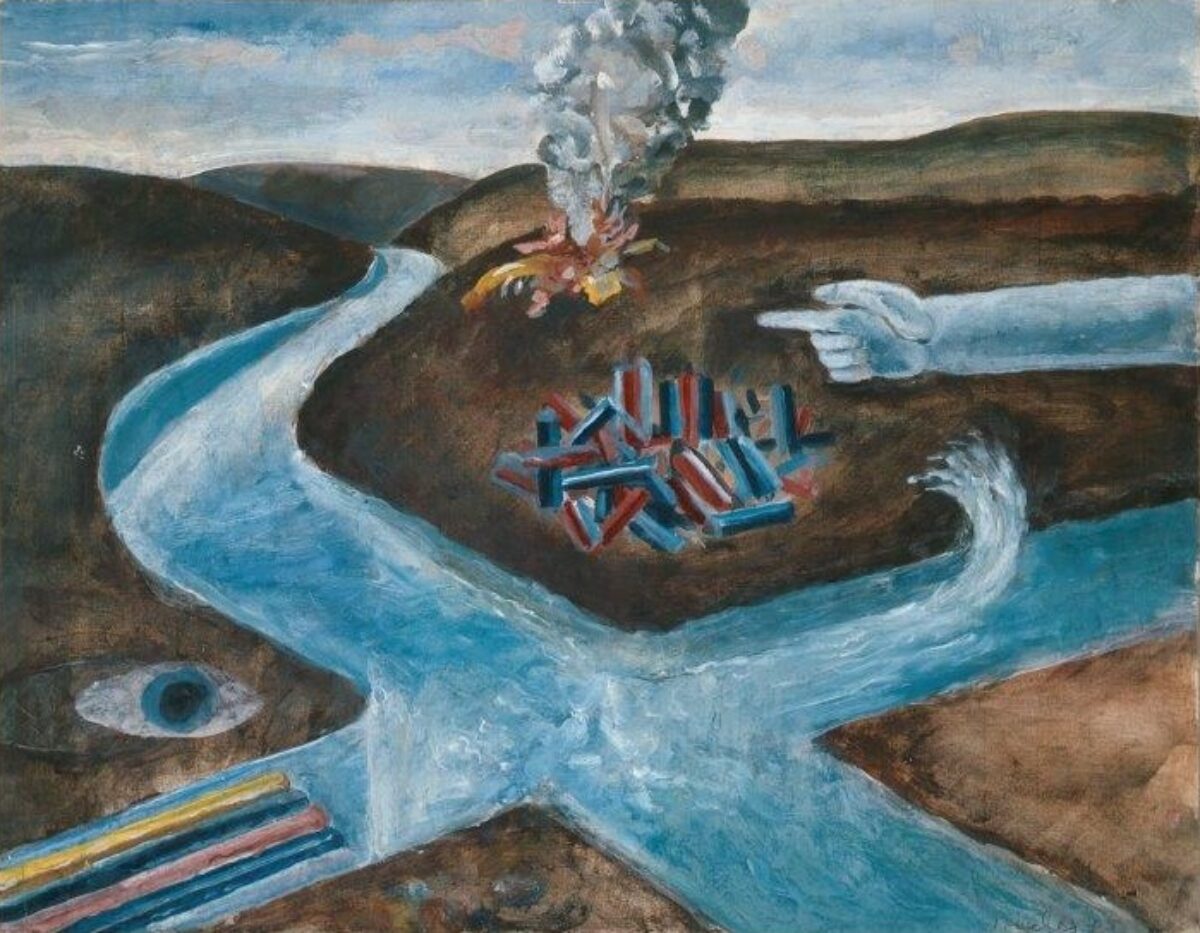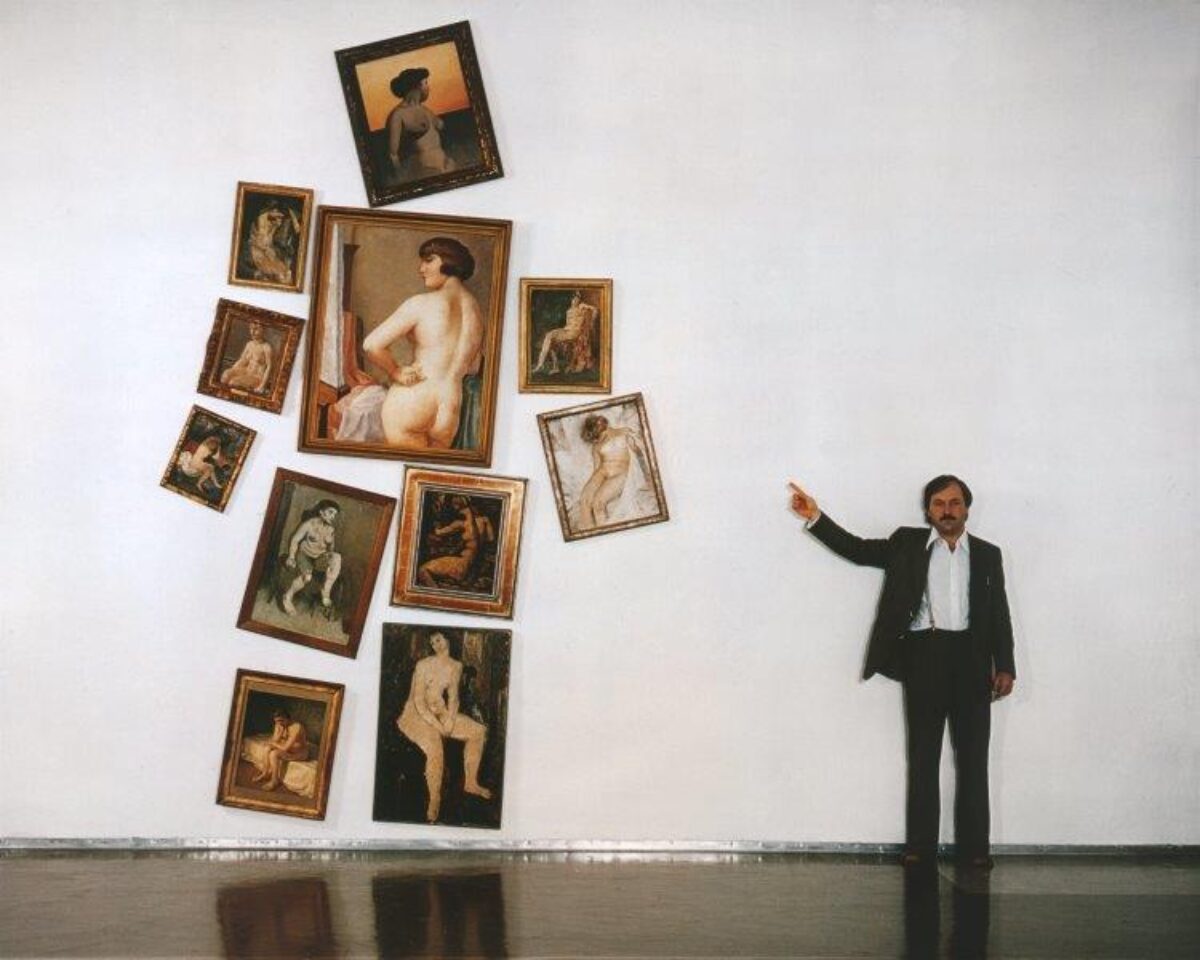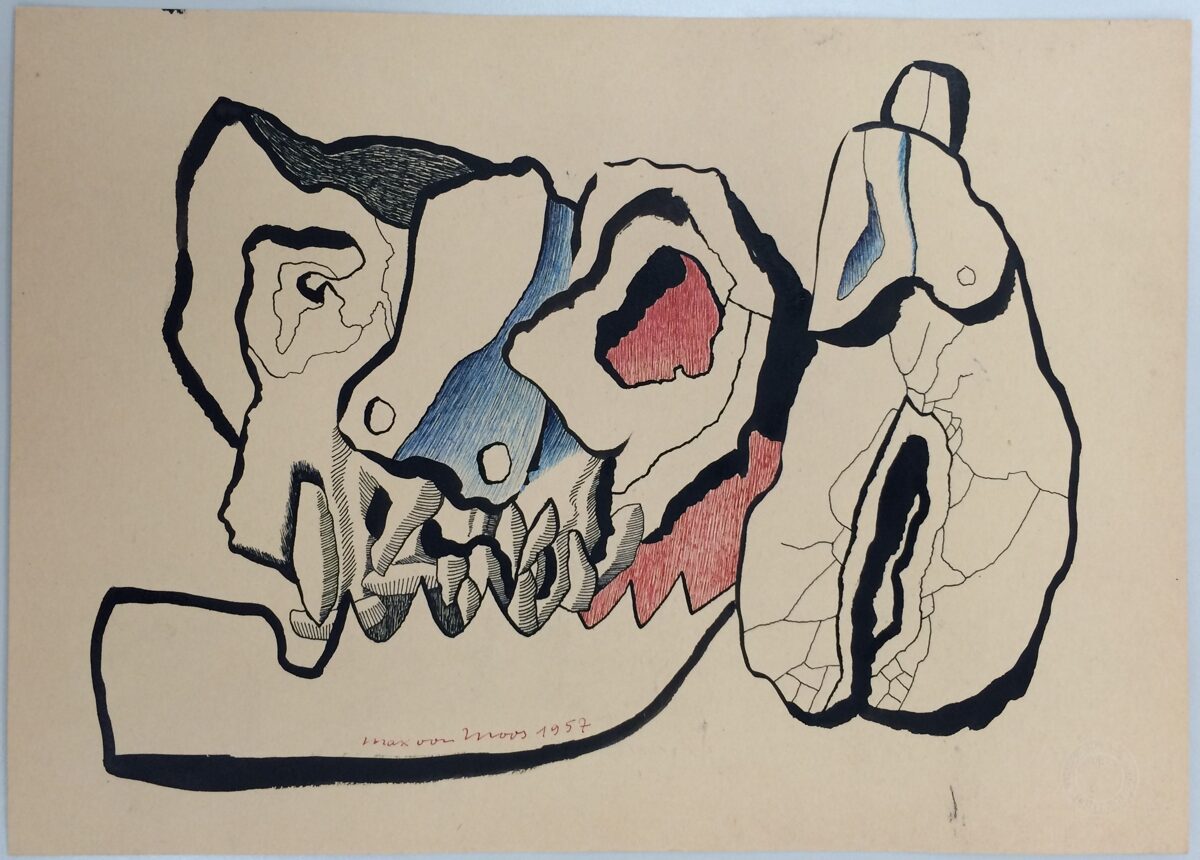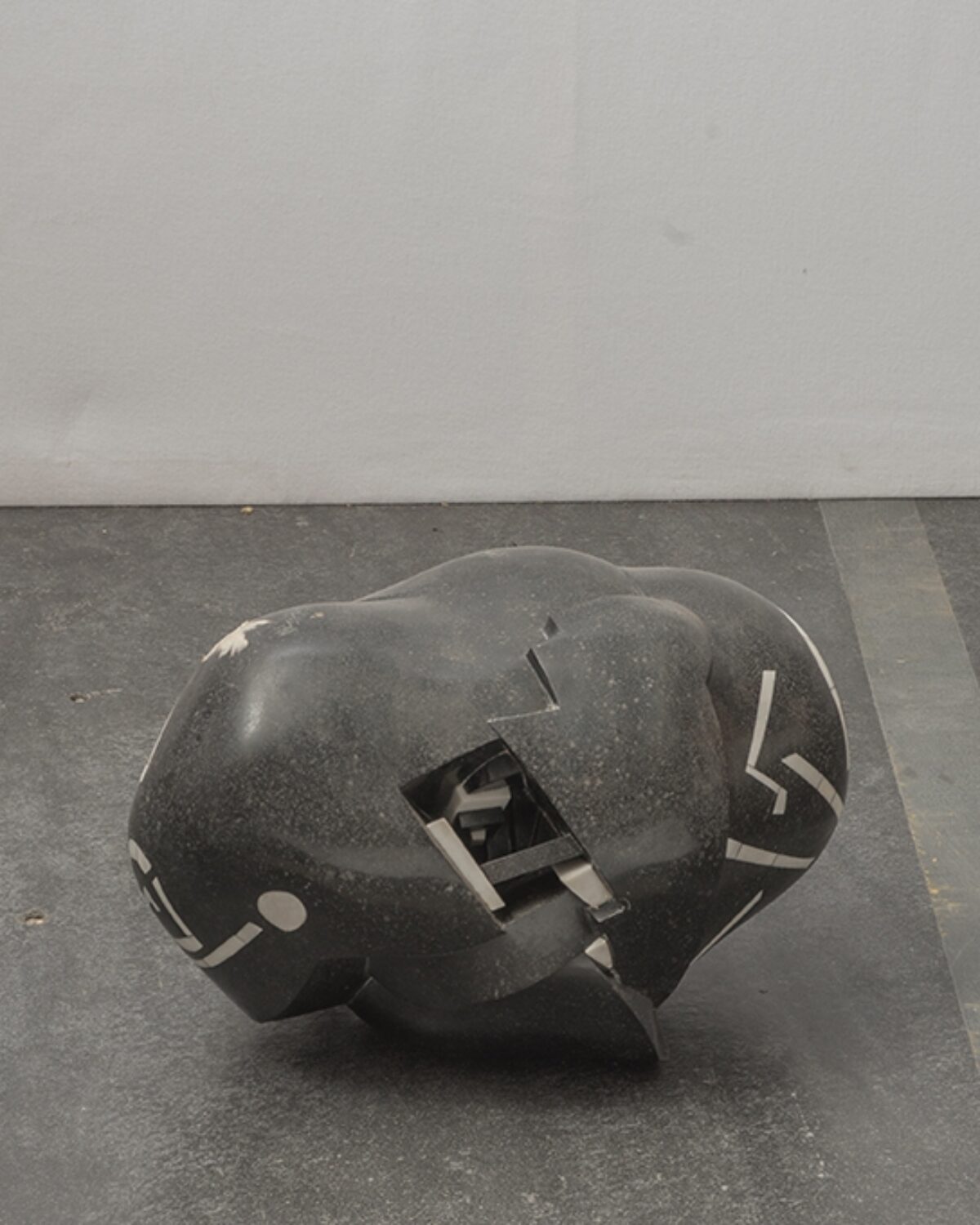
Oil on canvas, 79 x 60 cm, Gemälde
English, french and italian version below
Das Gemälde ist für einen Wettbewerb zum Thema Lebensfreude entstanden, den der Aargauische Kunstverein 1872 unter zehn ausgewählten Schweizer Künstlern zur Eröffnung seiner Sammlung ausgeschrieben hatte. Die Jury konnte sich zwischen Böcklins mythologischer, idealistischer Darstellung und Robert Zünds realistischem Gemälde „Am Sempachersee“ nicht entscheiden und entschloss sich in einem Kompromiss beide Werke zu erwerben. Damit gelangten schon früh zwei Hauptwerke in die Sammlung des Aargauer Kunsthauses.
Mit dem Titel bezieht sich Böcklin auf den griechischen Lyriker Anakreon aus dem 6. vorchristlichen Jahrhundert. Seine überlieferten Trink- und Liebeslieder sind eine Quelle für die deutsche Lyrik des späten 18. Jahrhunderts, insbesondere für die Dichtung Salomon Gessners (1730–1788) und des jungen Johann Wolfgang von Goethe (1749–1832). Als Anakreons Muse gilt gewöhnlich Euterpe, die Muse der tragischen und lyrischen Dichtkunst. In Böcklins Darstellung ist Euterpe mit dichtem, rot gelocktem Haar leicht nach links abgewendet und in Untersicht festgehalten. In ihrem antiken Chiton – dem Unterkleid der Griechen – und mit dem über ihre linke Schulter fallenden roten-goldenen Umhang wirkt sie feierlich. Ihr melancholisch anmutender Blick richtet sich in die Ferne. In beiden Händen hält sie eine Flöte, die auf das traditionelle Attribut Euterpes, die Doppelflöte, hinweisen. Den Hintergrund bilden ein leuchtend blauer, von weissen Wolken begleiteter Himmel und zwei Baumstämme, von denen einer hinter dem Kopf der Figur aufragt – eine Komposition, die Böcklin gerne anwendet. Ihre Vorteile sieht er in ihrer Auswirkung auf die Figurengestaltung: „Besonders günstig ist es bei Porträts Senkrechte anzubringen, wodurch die leiseste Bewegung im Kopf zur Geltung kommt.“
Das gleiche kompositorische Element setzt Böcklin im „Selbstbildnis“ (1873) in der Hamburger Kunsthalle ein: Der Künstler zeigt sich mit vor dem Oberkörper verschränkten Armen und auf den Betrachter gerichtetem Blick vor den Untersterblichkeitssymbolen Marmorsäulen und Lorbeer.
Böcklins Euterpe weist starke Ähnlichkeit mit seiner Tochter Clara auf, die ihm zu diesem Zeitpunkt oft Modell steht und im vorliegenden Gemälde in idealisierender Überhöhung dargestellt wird. Besonders charakteristisch für die Entstehungszeit des Bildes ist seine intensive Leuchtkraft, die einen Gegensatz zum vorherrschenden Zeitgeschmack bildete und vom Kunsthistoriker Heinrich Wölfflin 1948 kommentiert wird: „Da auf einmal – mit Beginn der siebziger Jahre – reisst der Wolkenschleier und die Welt entzündet sich in leuchtender farbiger Glut. Wie ein helles Trompetensignal tönt die ‚Muse des Anakreon‘ aus ihrer Umgebung heraus, und das mächtige Blau und Rot ist hier nur Begleitung zu der sprühenden Kraft des Auges.“
Karoliina Elmer
***
Böcklin creates the painting for a competition on the subject of “Joy of Life” which the Aargau Art Association organises in 1872 to mark the opening of its collection, inviting ten Swiss artists to participate. The jury is unable to choose between Böcklin’s mythological, idealistic portrait and Robert Zünd’s realistic painting “By Lake Sempach” and, in a compromise, decides to acquire both works. Thus, two major works find their way early on into the collection of the Aargauer Kunsthaus.
The title of Böcklin’s work refers to the sixth-century BC Greek lyric poet Anacreon whose drinking and love songs become a source of inspiration for late eighteenth-century German lyric poetry, notably the work of Salomon Gessner (1730–1788) and of the young Johann Wolfgang von Goethe (1749–1832). Anacreon’s muse is generally considered to be Euterpe, the muse of tragic and lyric poetry. In Böcklin’s painting, Euterpe is depicted with thick, curly red hair; her head turned slightly towards the left, she is seen from a low angle. The ancient chiton – the undergarment of the Greeks – she wears and the pink-gold cloak draped over her left shoulder make her look festive. She casts what seems to be a melancholic gaze into the distance. In both hands she holds a flute which alludes to the traditional attribute of Euterpe, the double flute. The background consists of a bright blue sky with white clouds and two tree trunks, one of which rises behind the head of the figure – a compositional element Böcklin favours for the effect it has on figural composition: “It is especially advantageous to include verticals in portraits, as they bring out even the slightest movement of the head.”
Böcklin employs the same element in his “Self-Portrait” (“Selbstbildnis”, 1873) at the Hamburger Kunsthalle where he shows himself with arms crossed in front of his chest and looking towards the viewer, with marble columns and laurel as symbols of immortality behind him.
Böcklin’s Euterpe has a strong resemblance to his daughter, Clara, who often poses for him at the time and is depicted in an exalted, idealised manner in this painting. Its intense luminosity is particularly characteristic of this period of Böcklin’s career and stands in contrast to the prevailing taste of the time. As the art historian Heinrich Wölfflin comments in 1948: “At that point, starting in the 1870s, the veil of clouds suddenly tears and the world ignites in a brightly coloured glow. Like a bright trumpet call, the ‘Muse of Anacreon’ sounds forth from its surroundings, and the mighty blue and red here are a mere accompaniment to the sparkling power of the eye.”
Karoliina Elmer
***
Le tableau fut réalisé à l’occasion d’un concours sur le thème de la joie de vivre, organisé par l’Aargauische Kunstverein en 1872 en vue de l’ouverture de sa collection et comptant dix artistes suisses sélectionnés. Ne pouvant trancher entre la représentation mythologique idéalisée de Böcklin et le tableau réaliste «Am Sempachersee» de Robert Zünd, le jury décida, en guise de compromis, d’acquérir les deux œuvres. Ainsi, deux œuvres majeures rejoignaient très tôt les collections de l’Aargauer Kunsthaus.
Le titre donné par Böcklin fait référence au poète lyrique grec Anacréon ayant vécu vraisemblablement au VIe siècle avant notre ère. Ses poèmes d’amour et de banquet passés à la postérité sont une source d’inspiration pour la poésie lyrique allemande de la fin du XVIIIe siècle, que l’on retrouve notamment dans les vers de Salomon Gessner (1730–1788) et du jeune Johann Wolfgang von Goethe (1749–1832). Muse de la poésie tragique et lyrique, Euterpe est habituellement considérée comme la muse d’Anacréon. Le tableau de Böcklin représente Euterpe cheveux épais aux boucles rouges, légèrement tournée vers la gauche et en contre-plongée. Avec son antique chiton – le sous-vêtement des Grecs – et sa cape rouge doré tombant de son épaule gauche, elle paraît solennelle. Ses yeux aux nuances mélancoliques regardent dans le lointain. Elle tient dans chaque main une flûte, référence à l’attribut traditionnel d’Euterpe, la flûte double. L’arrière-plan consiste en un ciel d’un bleu lumineux, accompagné de nuages blancs, et de deux troncs d’arbre, dont l’un se dresse derrière la tête du personnage: une composition à laquelle Böcklin aimait recourir et dont il voit les avantages dans son effet sur la figuration du personnage: «Il est particulièrement avantageux d’apporter des éléments verticaux dans les portraits, car ils mettent en relief le moindre mouvement de la tête.»
Böcklin utilise le même élément de composition pour le tableau «Selbstbildnis» (1873) dans la Kunsthalle de Hambourg: l’artiste se représente, bras croisés sur le torse et regard dirigé vers le spectateur, devant les symboles de l’immortalité que sont les colonnes de marbre et le laurier.
L’Euterpe de Böcklin présente de fortes similitudes avec sa fille Clara, qui lui servait à l’époque souvent de modèle et est ici représentée dans une pose idéalisante. Particulièrement caractéristique de la période de création du tableau, son intense luminosité est à l’opposé du goût dominant de l’époque et l’historien de l’art Heinrich Wölfflin la commente ainsi en 1948: «Et tout d’un coup – au début des années 1870 – le voile de nuages se déchire et le monde s’embrase dans un flamboiement coloré et lumineux. La „Muse des Anakreon“ retentit dans son entourage telle une claire sonnerie de trompettes et les puissants bleu et rouge ne sont ici qu’accompagnement de la force pétillante de l’œil.»
Karoliina Elmer
***
Il dipinto risale a un concorso sul tema della gioia di vivere indetto nel 1872 dall’Aargauischer Kunstverein tra dieci rinomati artisti svizzeri, in occasione della costituzione della propria collezione. La giuria non riuscì a decidersi tra il ritratto mitologico di stampo idealista di Arnold Böcklin e il dipinto di matrice realista di Robert Zünd intitolato “Am Sempachersee”. Con un compromesso decise infine di acquisire entrambe le opere. La collezione dell’Aargauer Kunsthaus poté così annoverare da subito due opere di particolare rilievo.
Il titolo, “La musa di Anacreonte”, si riferisce al poeta greco Anacreonte, vissuto nel VI secolo a.C. I suoi canti conviviali e d’amore costituiscono una fonte di ispirazione per la lirica tedesca di fine Settecento, in particolare per Salomon Gessner (1730-1788) e il giovane Johann Wolfgang von Goethe (1749-1832). La musa di Anacreonte è solitamente identificata con Euterpe, musa della poesia lirica e tragica. Nel dipinto di Böcklin, Euterpe guarda verso sinistra ed è rappresentata dal basso, con una folta capigliatura rossa e riccia. Il chitone – la tunica degli antichi greci – e il mantello rosso-dorato che ricade sulla spalla sinistra conferiscono alla figura un aspetto solenne. Lo sguardo melanconico è rivolto fuori campo, verso l’orizzonte lontano. In ciascuna mano la musa tiene un flauto, che rinvia al tradizionale attributo di Euterpe, il flauto doppio. Lo sfondo è costituito da un luminoso cielo blu con nubi bianche e da due tronchi, uno dei quali svetta dietro la testa della musa, secondo un principio compositivo privilegiato da Böcklin per l’effetto prodotto sul soggetto raffigurato, come egli stesso osserva: “Nei ritratti è particolarmente utile inserire delle dominanti verticali che pongono in risalto ogni minimo movimento del capo.”
Lo stesso elemento compositivo è utilizzato da Böcklin anche nel suo “Autoritratto” (1873) conservato alla Kunsthalle di Amburgo, in cui si presenta con le braccia conserte e lo sguardo rivolto verso lo spettatore, sullo sfondo di due colonne marmoree e di una pianta di alloro, simboli di immortalità.
L’Euterpe di Böcklin rivela una chiara affinità con la figlia Clara, che all’epoca posava spesso come modella per il padre e che nel quadro in esame è raffigurata in chiave idealizzante. Rispetto al proprio tempo, il dipinto si distingue soprattutto per la peculiare intensità cromatica, in aperta contraddizione con il gusto dell’epoca, come dichiara lo storico dell’arte Heinrich Wölfflin nel 1948: “Ed ecco che all’improvviso – all’inizio degli anni Settanta – il velo di nubi si lacera e il mondo si accende di un intenso ardore cromatico. Come un luminoso segnale di tromba, la ‘Musa di Anacreonte’ risuona nel suo ambiente e i possenti blu e rosso sono un mero accompagnamento alla forza scintillante dello sguardo.”
Karoliina Elmer

